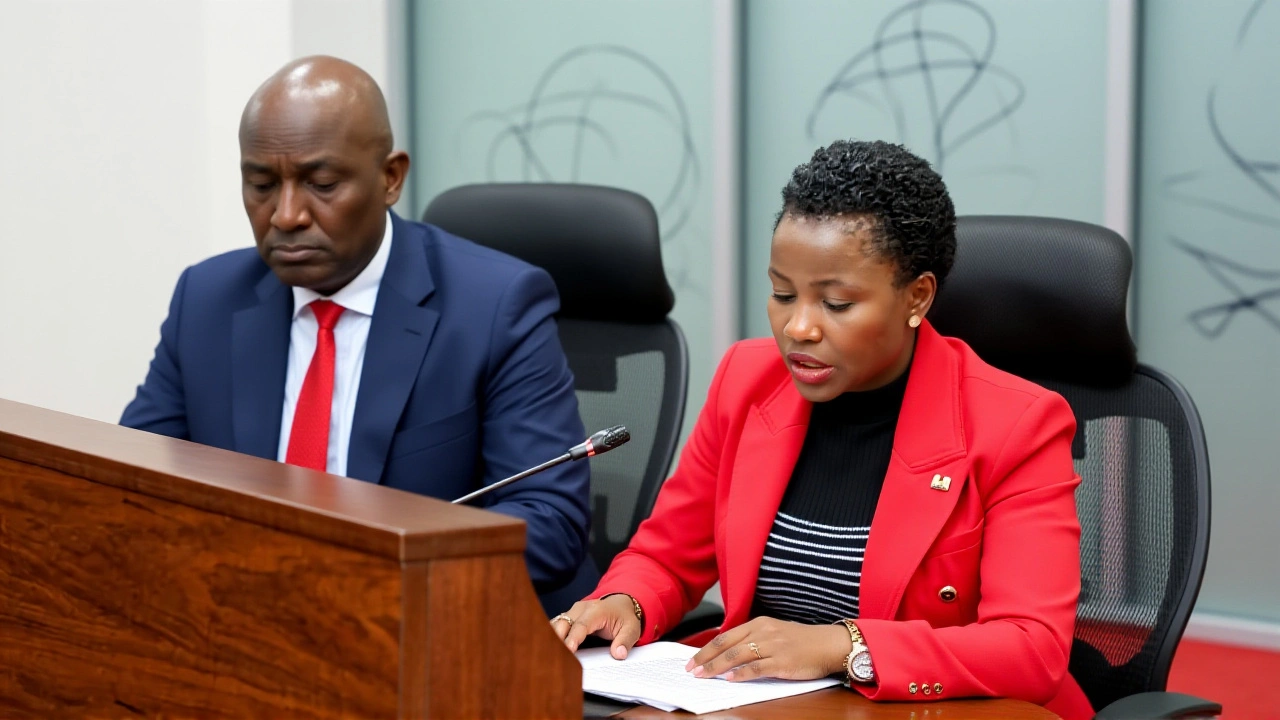During Madaraka Day addressKenya, William Ruto, President of Kenya unveiled a KES 20 billion youth programme backed by the World Bank. The initiative, dubbed the National Youth Opportunities Towards Advancement (NYOTA) Project, is slated to touch more than 820,000 vulnerable young Kenyans over five years, offering apprenticeships, seed capital and a raft of financial‑inclusion services.
Background and Political Context
NYOTA sits at the heart of President Ruto’s Bottom‑Up Economic Transformation Agenda (BETA), a policy thrust that seeks to shift growth from large‑scale industry to grassroots entrepreneurship. The programme was first hinted at in the president’s 2024 State of the Nation speech, but it only gained concrete shape during the 2025 Madaraka Day ceremony. By earmarking KES 20 bn, the government hopes to address a chronic youth unemployment rate that has hovered around 21 % for the past decade.
The timing is crucial. Kenya’s fiscal 2025‑26 budget, presented by Wycliffe Oparanya, Cabinet Secretary for National Treasury, earmarked a specific line item for NYOTA, signalling that the funds are not just a political promise but a budgeted commitment.
Program Structure and Pillars
NYOTA’s design rests on four interlocked pillars:
- Employability: Structured apprenticeships and Recognition of Prior Learning (RPL) pathways that let youths earn a credential while on the job.
- Entrepreneurship: Access to seed capital, mentorship and market linkages for start‑ups and social enterprises.
- Savings & Financial Inclusion: Partnerships with the National Social Security Fund (NSSF) to extend the Haba Haba savings scheme to participants.
- Institutional Support: Capacity‑building for youth agencies and streamlined access to Government Procurement Opportunities (AGPO).
Each pillar is overseen by a different line ministry but coordinated through a multi‑agency steering committee that includes the Micro and Small Enterprises Authority (MSEA), National Employment Authority (NEA), National Industrial Training Authority (NITA) and the State Department of Youth Affairs & Creative Economy.
Rollout Details and Early Implementation
Implementation kicked off in early August 2025 when three senior cabinet secretaries huddled at State House to fine‑tune the rollout plan. Alfred Mutua, Cabinet Secretary for Labour and Social Protection said, “Together with my colleagues, we have refined a model that should change the future for thousands of Kenyan youths.” The first cohort of trainees gathered in Mt Elgon Sub‑County, Bungoma, where Augustine Mayabi, National Project Manager for NYOTA addressed a crowd of 90,000 hopefuls after a four‑day intensive workshop.
Key rollout metrics include:
- Target of 70 youths per ward, translating to roughly 3,150 beneficiaries in Bungoma County alone for the inaugural round.
- Training of 90,000 youths in job‑experience placements and 20,000 participants in RPL certification.
- More than 1 million applications received for the entrepreneurship component since the portal opened on 11 July 2025.
- Funding disbursement to county governments beginning 15 September 2025, with quarterly monitoring reports due to the World Bank.
The programme’s reach is truly national – every one of Kenya’s 47 counties will host NYOTA centres, and the selection criteria focus on form‑four leavers, informal‑sector workers and persons with disabilities aged 18‑29 (35 for PWDs). In practice, this means that youths living in informal settlements of Nairobi’s Eastlands will sit side‑by‑side with those in remote villages of Turkana.
Stakeholder Reactions and Expert Views
Youth groups have greeted the launch with cautious optimism. The Kenya Youth Coalition’s chair, Grace Mwangi, noted, “The sheer volume of applications tells us there is massive demand – we just hope the implementation matches the promise.” Conversely, the opposition Kenya African National Union (KANU) warned that “without stringent audit mechanisms, the KES 20 bn could be siphoned off.”
Economists at the University of Nairobi’s Centre for Development Studies weighed in, highlighting that “if even 10 % of the beneficiaries manage to launch viable SMEs, the ripple effect on GDP could be in the low‑single digits by 2030.” They also cautioned that the success of the Savings pillar hinges on financial‑literacy training that truly resonates with rural youths.
Implications for Kenya’s Youth and Economy
Beyond the headline numbers, NYOTA could reshape Kenya’s labour market dynamics. By pairing apprenticeships with formal certification, the programme tackles the credential gap that often blocks youths from formal employment. Meanwhile, the entrepreneurship stream aims to nurture a new generation of “home‑grown” innovators, reducing reliance on foreign capital.
Should the rollout stay on schedule, the World Bank has indicated a willingness to inject an additional KES 5 bn for a “Scale‑Up Phase” in 2028, provided key performance indicators are met. In practical terms, that could mean expanding the AGPO access portal to include 2,000 more SMEs each year.
At the community level, the initiative is already sparking change. In Bungoma, a 21‑year‑old trainee, James Otieno, shared that the apprenticeship in a local poultry farm gave him a “steady income for the first time in years.” Such stories, while anecdotal, hint at a broader social impact that could lower poverty rates in Kenya’s most vulnerable regions.
What’s Next?
The next major milestone is the mid‑year audit scheduled for December 2025, during which the World Bank will review disbursement reports and beneficiary feedback. Following that, the cabinet plans to introduce a “Digital NYOTA Dashboard” that will let youths track their application status, training schedules and loan eligibility in real time.
In the longer view, the programme’s sustainability will depend on how well the Institutional Support pillar strengthens local agencies. If county governments can embed NYOTA’s frameworks into their own development plans, the impact could outlive the five‑year funding cycle.
Frequently Asked Questions
How will NYOTA benefit unemployed youth in rural Kenya?
The programme’s Employability pillar offers apprenticeships and Recognition of Prior Learning, giving rural youths a pathway to earn recognized credentials while earning a stipend. Early reports from Bungoma show participants receiving up to KES 5,000 per month, which can cover basic living costs while they train.
What role does the World Bank play in NYOTA?
The World Bank provides the bulk of the KES 20 bn financing and sets monitoring frameworks. It will also conduct a mid‑term evaluation in December 2025 to decide whether to release an additional KES 5 bn for a scaling phase.
Who is eligible for the entrepreneurship component?
Kenyan citizens aged 18‑29 (or up to 35 for persons with disabilities) who are unemployed or earn less than KES 15,000 per month can apply. Applicants need to submit a basic business plan and undergo a short training module on financial literacy.
How will the Savings and Financial Inclusion pillar work?
Through the National Social Security Fund’s Haba Haba scheme, NYOTA participants can open low‑interest savings accounts that match every KES 100 saved with an additional KES 50 from the government, encouraging regular deposits.
What are the next steps for counties that have not yet received funds?
County governments must submit a detailed implementation roadmap to the national steering committee by 30 September 2025. After approval, the first tranche of funds will be released in mid‑October, followed by capacity‑building workshops for local officials.







Comments
jyoti igobymyfirstname
OMG this NYOTA thing is like a massive glow‑up for Kenyan youths!
ritesh kumar
NYOTA is just a textbook example of a neo‑colonial cash‑dump disguised as empowerment; the World Bank’s fingerprints are all over the budget line.
It reeks of strategic resource capture rather than genuine grassroots upliftment.
Raja Rajan
The program has potential but its execution must be transparent.
Without strict monitoring the funds could evaporate.
Stakeholders need clear metrics.
Atish Gupta
Seeing Kenya take bold steps toward youth empowerment is heart‑warming.
I truly believe that if the apprenticeship tracks are well‑managed, a generation of innovators will emerge.
Let’s keep the momentum alive!
Aanchal Talwar
Great initiative! I hope the seed capital actually reaches the grassroots and not get lost in paperwork.
Best wishes to all the young entrepreneurs.
bhavna bhedi
From a cultural standpoint this could reshape how youth view work and community.
The blend of traditional apprenticeship with modern finance is quite promising.
Apu Mistry
In the grand tapestry of development, NYOTA is a single thread that could either bind or unravel the fabric of society.
One must wonder whether the loom is steady enough for such an ambitious weave.
Ananth Mohan
As a mentor I’d say the key is hands‑on guidance; youths need more than cash, they need seasoned advice.
County officials should pair each apprentice with an industry veteran to maximise impact.
Abhishek Agrawal
While the enthusiasm is admirable, one must ask: are we setting expectations too high?
History shows that large‑scale programmes often falter under bureaucratic weight; vigilance is essential.
Rajnish Swaroop Azad
The stakes are monumental, and the dreams of a million youths swarm like a storm.
Yet, without relentless focus, the thunder may fade before it reaches the valleys.
Zoya Malik
Critically, the success metrics must be clearly defined; otherwise the narrative becomes mere hype.
Neha Shetty
Honestly, this feels like a turning point for Kenya’s socio‑economic landscape.
When youths see real pathways to skill acquisition, it reshapes societal expectations.
I’m optimistic that the Savings pillar, if executed with genuine financial education, could foster a culture of thrift that lasts generations.
Let’s hope the digital dashboard lives up to its promise of transparency.
uday goud
What a kaleidoscope of ambition! 🌈 The intertwining of apprenticeships, seed capital, and digital tracking forms a mosaic of possibility.
If the colors blend well, Kenya could set a radiant example for the continent.
Harsh Kumar
To all the young change‑makers out there – keep pushing forward! 🚀 Your perseverance will light the way for countless others.
suchi gaur
Ah, the elite chorus sings again – perhaps the next verse will be written by the very youths they claim to empower? 🎭
Rajan India
Looks like a solid plan on paper; hope the ground reality matches the hype.
Parul Saxena
When one contemplates the magnitude of NYOTA, it becomes evident that this is more than a mere policy – it is a generational promise.
First, the apprenticeship streams bridge the chasm between informal labor and formal credentialing, offering youths a tangible ladder out of precarious livelihoods.
Second, the entrepreneurship wing, bolstered by seed capital, provides the catalytic spark necessary for innovative ventures to ignite.
Third, the integration with the Haba Haba savings scheme could instill disciplined financial habits, a cornerstone for long‑term economic stability.
Moreover, the multi‑agency steering committee, if truly coordinated, may streamline bureaucratic red tape that traditionally stalls progress.
Equally important is the role of county governments; their localized insight ensures that interventions are contextually relevant, avoiding one‑size‑fits‑all pitfalls.
The anticipated mid‑year audit presents an opportunity for transparent assessment, fostering accountability among stakeholders.
Should the World Bank’s additional funding be unlocked, scaling could accelerate, reaching remote regions previously left untouched.
Nonetheless, challenges persist: monitoring mechanisms must be robust to prevent misappropriation, a concern echoed by civil society groups.
Additionally, the success of the financial inclusion pillar hinges on effective literacy programs that resonate with both urban and rural youths.
It is also vital that the digital NYOTA Dashboard remains user‑friendly, avoiding technological barriers that could exclude the very beneficiaries it aims to serve.
In the broader macroeconomic context, empowering a fifth of Kenya’s population could stimulate domestic demand, potentially nudging GDP growth upward.
Finally, the cultural shift towards valuing skill acquisition over informal labor can reshape societal attitudes, fostering a more resilient workforce.
In sum, NYOTA stands at a crossroads; its ultimate impact will be determined by execution fidelity, stakeholder collaboration, and unwavering political will.
Vishal Kumar Vaswani
Reading between the lines, one wonders if hidden agendas are at play, steering funds toward unseen channels.
Stay vigilant, folks.
Gurjeet Chhabra
It’s encouraging to see such a comprehensive approach; hope the community feels the positive impact soon.